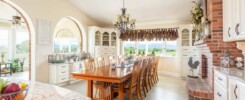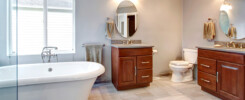What was anticipated as a pleasant and simple task of choosing colors at the local paint store has instead become a nightmare of choices, added to by the time pressures which I call the “the arbitrary tyranny of the painter,” when in fact, choosing life-enhancing colors takes careful consideration. Use the color tips from the color experts and professional remodeling contractors.
First tip: If you want happy results, it’s not a good idea to rush this process. Tell the painter to come back when you are ready and set a time frame in which to make your choices. Even then, have the painter help you test out a couple of colors before launching into the project. Do not be afraid to make adjustments if you are unhappy.
To help you here are some factors influencing perception to consider:
- The time of day the area will be most used.
- The type of light it will be viewed in.
- The juxtaposition of colors surrounding it.
- The size or scale of the area.
- The general age of the people using the room.
- The intended activities of the space.
Explanations:
Color and Light are really synonymous. One cannot be seen without the other. The color of daylight itself varies from zone to zone; and each hour of day and brings a change to perception. Sunny days in Mexico render color differently than a cloudy day in Minneapolis. The classic north light of an artist’s skylit studio is actually a cool light. Each type of light bulb renders a different color emphasis. Halogen is very close to the full spectrum of sunlight, incandescent lamps are on the warm, orange scale. Fluorescent lamps are usually more blue; though some are called full-spectrum. It is important to see your color choice in the lamps to be used. Each will render the color differently.
Usually exterior elements are reflected onto the walls. In a garden or wooded setting greens will be present. White with a pink tint will end up looking murky because red and green equal brown. Surprisingly a white with a slightly greenish-umber cast may actually look softer and warmer, especially as you work with other interior colors.
If the room is to be used mainly in the evenings, then the artificial lighting will be an important factor. Generally, we use incandescent lamps in living, dining & bed rooms. Their warm, golden light will amplify and enrich warm colors, reds, oranges, yellows. Greens will tend to become more yellow than when viewed during the day. Blues will take on a slightly green tint under this light. That’s why you should consider the natural and artificial light of your space in your remodeling design and painting plans.
The human eye changes with age. As the lens thickens, golden tones are clearer than blues and greens. Contrasts of subtle color differences diminishes, so stronger differences in color relationships may be more interesting. However, a dark border on a carpet may be perceived as a step down into space, and become unnerving. It is an interesting challenge, as a designer, to create a color scheme of brightness and sufficient contrasts, which flatters the sophistication and experience of elderly rather than imparting a patronizingly immature look.
The youthful eye makes more distinctions and may enjoy richer color relationships than the standard primary colors we so often associate with primary-age settings. Though, if used interestingly, those can be upbeat and distinctive.
You will find it helpful to know the following three basic elements to color:
- Hue — the color itself — Blue, Red, Green, Yellow, etc.
- Value — the relative lightness or darkness of a color, whiteness or blackness.
- Intensity — the saturation or brightness of a color.
Psychological, emotional, and spiritual reactions are created by the mixture of these elements. Environmental color supports various moods and activities, from resting and dreaming to socializing and invigorating the appetite. It’s best to consider carefully the requirements of the space and to consult with an experienced color & lighting specialist who can work with you to create a successful space. Watch this website for more color hints. It’s one of our favorite topics.



